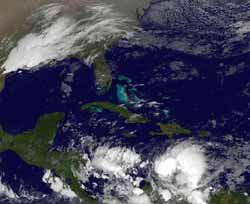GOES-13 catches Tropical Storm Tomas' early morning strengthening

The GOES-13 satellite captured a strengthening Tropical Storm Tomas this morning, Nov. 2 at 0845 UTC (4:45 a.m. EDT) in infrared imagery. Tomas appears as the rounded area of clouds (bottom right) about 310 miles due south of Port Au Prince, Haiti. In the larger image, the clouds over northwestern Louisiana (top left) are from a low and associated cold front stretching southwest to north-central Mexico.<br>Credit: NOAA/NASA GOES Project<br><br>
The Geostationary Operational Environmental Satellites like GOES-13 are managed by NOAA. The NASA GOES Project at NASA's Goddard Space Flight Center in Greenbelt, Md. creates images and animations from the GOES satellite data. When GOES-13 provided an infrared image (because it was taken at night) today, Nov. 2 at 0845 UTC (4:45 a.m. EDT), Tropical Storm Tomas showed a little more organization in its clouds after battling wind shear yesterday.
Infrared satellite data also showed that convection (rapidly rising air that form the thunderstorms that make up a tropical cyclone) has increased or deepened in Tomas. This morning most of that convection and thunderstorm activity is occurring over the eastern and northeastern areas around the center of circulation.
The wind shear over the south-central Caribbean Sea has weakened which has allowed Tomas to gradually re-strengthen. The waters are also much warmer than the 80 degree threshold needed to maintain or strengthen a tropical cyclone. Because of these improving conditions, the National Hurricane Center forecasts that Tomas will continue strengthening until Friday when an upper-level trough (elongated area of low pressure) will push Tomas north-northeastward toward the Windward Passage and parts of Hispaniola.
At 5 a.m. EDT, Tropical Storm Tomas had maximum sustained winds near 50 mph (up from 45 mph on Nov. 1). Tomas is moving west near 12 mph and has a minimum central pressure of 1003 millibars. The center of Tomas is located about 355 miles south of Port-au-Prince, Haiti near 13.5 North and 72.0 West. Tomas is being steered along the southern and southwestern edge of ridge (an elongated area) of high pressure which is moving Tomas west.
To visualize Tomas' movement, picture a penny on a table and move your finger from the bottom of the penny to the left. The penny is the area of high pressure, and your finger would be Tomas. High pressure areas act as a wall that tropical cyclones can't penetrate, so they move around the edges.
Tomas is forecast to become a hurricane on Thursday, Nov. 4 and turn to the northeast, threatening Haiti. Currently there are no watches and warnings in effect, but that's likely to change later this week.
Media Contact
More Information:
http://www.nasa.govAll latest news from the category: Earth Sciences
Earth Sciences (also referred to as Geosciences), which deals with basic issues surrounding our planet, plays a vital role in the area of energy and raw materials supply.
Earth Sciences comprises subjects such as geology, geography, geological informatics, paleontology, mineralogy, petrography, crystallography, geophysics, geodesy, glaciology, cartography, photogrammetry, meteorology and seismology, early-warning systems, earthquake research and polar research.
Newest articles

Bringing bio-inspired robots to life
Nebraska researcher Eric Markvicka gets NSF CAREER Award to pursue manufacture of novel materials for soft robotics and stretchable electronics. Engineers are increasingly eager to develop robots that mimic the…

Bella moths use poison to attract mates
Scientists are closer to finding out how. Pyrrolizidine alkaloids are as bitter and toxic as they are hard to pronounce. They’re produced by several different types of plants and are…

AI tool creates ‘synthetic’ images of cells
…for enhanced microscopy analysis. Observing individual cells through microscopes can reveal a range of important cell biological phenomena that frequently play a role in human diseases, but the process of…





















